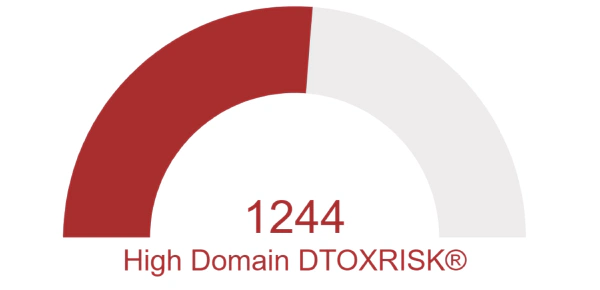Which SEO metrics should we use in link building?
Auch verfügbar in Deutsch: Welche SEO-Metriken sollten wir beim Link-Building verwenden?Table of Contents

As SEOs, link building is, without any doubt, one of the most powerful tools we have at our disposal. Build good links, and your clients’ websites will climb up in the ranking accordingly. Happy client :)
Nonetheless, link building is getting harder, and Google is always changing its algorithms. Being SEO pros, we need to stay on our toes and be always up-to-date with the core of link building: the metrics.
To support your efforts, I have compiled a list of the four most essential metrics we need to check to build those juicy links for our clients and stay ahead of the pack. Let us get started, shall we?
1. Link Detox Risk #

Link Detox Risk is a unique metric developed by LinkResearchTools. It uses automated rules to calculate the risk of a link (or website) becoming a target of a Google penalty.
Why use Link Detox Risk and not just popular DR (short for “Domain Rating”) metric in Ahrefs?
The answer is simple: they are not the same and DR is nowhere near as effective as a link building tool as Link Detox Risk is.
The reason for this is because DR is often based on old crawl data and only counts the number of referring domains. Ahrefs DR, as well as Moz DA, measure a whole domain by collecting metrics for pages and calculating an average.
Links are measured on a page level, though.
A link is a connection from one page to another, not a domain to another domain. A domain is just an aggregation of pages with links.
Put simply: You cannot judge a page by domain-based metrics. Even Google themselves confirmed that they do not have any domain-wide metrics.
2. Link Trust #
![]()
To build high-quality links, those links must be trustworthy in the algorithmic eyes of Google. This trust is not easy to manufacture. Trust is inherited from the source page of your links. The more trust a source page has, the more trust it confers to the target page, meaning the page you are building the links to.
To measure the trust of a source website, LRT has a metric called “LRT Trust”, which is not available in other tools.
3. Link Power #
![]()
Link Power is the second pillar of the two-dimensional measuring system of link quality in LRT. “Link Power” is somewhat similar to the old Google Page Rank or the UR rating in Ahrefs and measures the power of a website.
Link Power decides, in conjunction with the Link Trust described above, the quality of the link you are looking to build.
If you only look at a power metric (like Ahrefs UR) then you are missing out.
If you only look at a domain wide metric to judge on links (like Moz DA or Ahrefs DR) you are completely off.
Only LRT presents you the data for Link Trust and Power of links. With this data, you can use our matrix of trust and power, which makes deciding on links easy. If you have a link with low power and low trust, it is weak and not worthy of your time.
A link with high power but low trust we call “Nitro”. You must check those links carefully so their overpowered ability does not backfire. On the other hand, a link with low power but high trust is a “High Potential” link and goes on your watchlist. What you are really looking for are the “Awesome Superstars”, as we at LRT call them.
Those superstar links have high trust and high power, making them an optimal addition to your backlink profile.
How can you measure Link Power, Link Trust, and Link Risk quickly and effectively? #
The best way to measure those metrics easily and effectively is the LRT Link Simulator. It will present you the Link Detox Risk (most essential to avoid Google penalties) and the LRT Power and the LRT Trust.
Moreover, you can not only use it for your existing links but for links you still do not have. That makes the tool invaluable for checking any links before building them, thus avoiding potential troubles before they even occur.

4. Anchor texts #
Finally, you must have a look at the anchor texts of your links. Being the clickable text in your links, Google scans those texts to judge if your website is relevant or a spammy beast it will ignore.
Also, keep in mind the importance of the relevance of your links, anchor text, and surrounding context. The topic of link relevancy will be discussed independent from any technical SEO metrics.
The text that you see when clicking on a link is called anchor text.
<a href="https://smart.linkresearchtools.com">Best Link Tool</a>
In the above example, the phrase “Best Link Tool” is the anchor text. And it’s a “Money keyword.” Managing different keyword classifications is a core feature of LRT. You will learn in other articles why it’s so important to use keyword classes and worry about anchor text diversity.
Video on Link Building Metrics #
This video was the basis for this post, check it out for more details.


